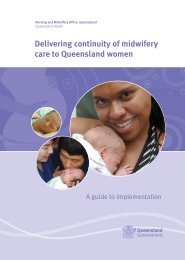Gold Coast Birth Centre - Queensland Centre for Mothers & Babies
Gold Coast Birth Centre - Queensland Centre for Mothers & Babies
Gold Coast Birth Centre - Queensland Centre for Mothers & Babies
You also want an ePaper? Increase the reach of your titles
YUMPU automatically turns print PDFs into web optimized ePapers that Google loves.
Private Hospitals<br />
The number and percentage of women who provided responses to the 2010 Having a Baby in <strong>Queensland</strong> Survey <strong>for</strong> each<br />
private hospital are provided below.<br />
Number of respondents Response rate<br />
Cairns Private Hospital 93 41%<br />
John Flynn Private Hospital 108 42%<br />
Mater Misericordiae Hospital Gladstone 34 46%<br />
Mater Misericordiae Hospital Mackay 122 45%<br />
Mater Misericordiae Hospital Rockhampton 110 47%<br />
Mater Women’s and Children’s Hospital Townsville 146 41%<br />
Mater <strong>Mothers</strong>’ Private Hospital (South Brisbane) 761 49%<br />
Mater <strong>Mothers</strong>’ Private Redland 68 46%<br />
Nambour Selangor Private Hospital 148 48%<br />
North West Private Hospital 297 48%<br />
Pindara Private Hospital 242 43%<br />
St Andrew’s Ipswich Private Hospital 68 50%<br />
St Vincent’s Hospital Toowoomba 175 44%<br />
Sunnybank Private Hospital 190 41%<br />
Sunshine <strong>Coast</strong> Private Hospital 83 51%<br />
Wesley Private Hospital 283 48%<br />
STATEWIDE PRIVATE HOSPITALS 2,935 46%<br />
Representativeness of Respondents<br />
The survey respondents include women who had live births (single and multiple births) in <strong>Queensland</strong> between February 1 and<br />
May 30, 2010. The representativeness of survey respondents was compared with population statistics reported <strong>for</strong> women who<br />
gave birth in <strong>Queensland</strong> in 2008 (based on Australia’s <strong>Mothers</strong> and <strong>Babies</strong>, and Perinatal Statistics <strong>Queensland</strong>) on several key<br />
indices 2 . It is important to note that these comparisons provide an estimate only of sample representativeness given that<br />
population statistics are not yet publically available <strong>for</strong> women who gave birth in 2010. Additionally, the 2008 population<br />
statistics include women who experienced a stillbirth or a neonatal death, however these women are not included in the Having a<br />
Baby in <strong>Queensland</strong> data presented in this report.<br />
Relative to the women who gave birth in <strong>Queensland</strong> in 2008 (Laws et al., 2010; <strong>Queensland</strong> Health, 2010), the respondent<br />
sample under-represented the following groups:<br />
− Multiparous women (54.6% in the respondent sample vs. 60.0% of all birthing women in <strong>Queensland</strong>)<br />
− Aboriginal and/or Torres Strait Islander women (1.7% in the respondent sample vs. 5.6% of all <strong>Queensland</strong> birthing<br />
women)<br />
− Younger women (aged
















